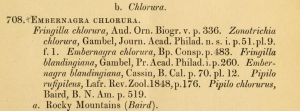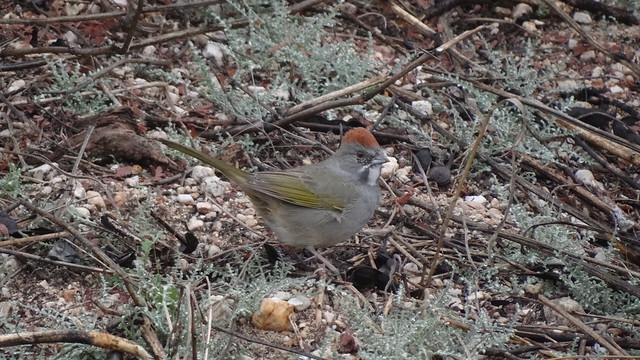In 1896, Robert Ridgway proposed to make of the green-tailed towhee
the type of a new genus, Oreospiza, whose characters are intermediate between, or rather a combination of, those of Pipilo and Zonotrichia.
Sensible enough, given the bird’s wing structure and head pattern, and the AOU adopted the new name in the next year’s Supplement to the Check-list.
Thereupon roared forth, in a manic mood, Elliott Coues.
In a short and malignant letter to the editor of the Auk, Coues confessed himself inclined to agree that the green-tailed was generically distinct from other towhees, but at the same time felt the need to point out that
I could produce some manuscript, in my own handwriting, of date 1862, in which I took the bird entirely out of the genus Pipilo; though I never published that screed, chiefly because my mentor at that time, Professor Baird, was vexed at something I did with Bonaparte’s genus Kieneria.
Resentment piles up atop 35-year-old resentment. But Coues’s real difficulty is the sequence of the towhees: the AOU has, in both editions of its list, “interjected forcibly” the green-tailed towhee
in the middle of its supposed genus, with the black or green and white Towhees in front of it, and the brown Towhees behind it; with the interesting result, that Oreospiza, the heterogeneous element or unconformable factor in the case, now splits Pipilo apart!
Coues is not to blame, though, as he hastens to add:
I gladly leave this case to the tender grace of any one who will admit his responsibility for putting “Pipilo” chlorurus in that fix. I decline to assume any responsibility myself; the bird will be found in several of my works since 1872 in what I took to be its proper position.
Indeed, in all the successive editions of the Key, published in 1872, 1884, 1887, 1890, and — posthumously — 1903, the green-tailed is placed at the end of the towhees. Starting with the second edition, Coues included a note about the bird’s affinities: it is, he writes,
of no intimate relations with any other; it has long been placed conventionally in Pipilo, for want of a better location; it is not easy to see how it differs in form from Zonotrichia or Embernagra.
If I’ve kept track correctly, this short letter efficiently sideswipes Robert Ridgway — for failing to acknowledge Coues’s intellectual priority — Spencer Baird — for disagreeing with Coues’s treatment of Kieneria — Charles Bonaparte — for raising the genus in the first place — and the rest of the AOU’s checklist committee — for forcing the green-tailed into an unnatural position in the tally.
Baird and Bonaparte were dead, and Ridgway, apparently declining to respond to Coues’s outburst, simply pointed out that he had himself been pondering the distinctness of the green-tailed towhee for some time.
The AOU, however, was still restive. In 1915, Charles Richmond pointed out that Ridgway’s Oreospiza was pre-occupied, having already been used (and more appropriately, at that) by the specimen dealer G.T. Keitel for the snowfinches. Richmond coined the new genus name Oberholseria for the green-tailed towhee, and that name was used in the fourth edition of the Check-list.

In 1947, on the determination that Chlorura was available and predated Richmond’s name — it had first been published, as a subgenus name, for the towhee in 1862 — the twenty-second supplement assigned the bird to yet another genus, making it Chlorura chlorura, the green-tailed greentail, in the fifth edition of the Check-list.
And it wasn’t over yet. Things came full circle in 1955, when Charles Sibley argued cogently that the green-tailed towhee was best assigned to the same genus as the spotted and collared towhees — namely, Pipilo, the genus from which it had been removed it in 1896.
No response so far from Elliott Coues.




